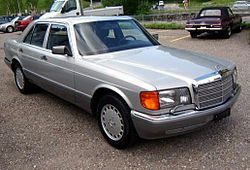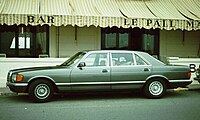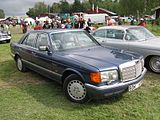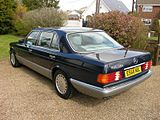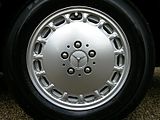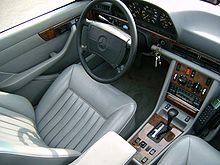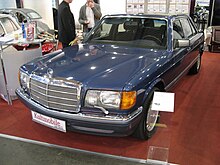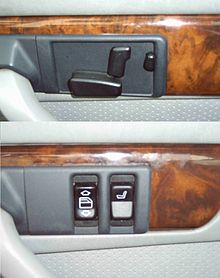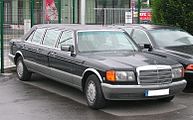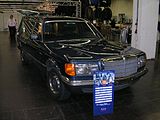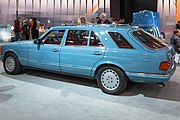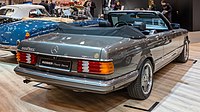Mercedes-Benz model series 126
| Mercedes Benz | |
|---|---|
|
Mercedes-Benz 420 SE
|
|
| 126 series | |
| Sales designation: | 260 - 560 (S, SE, SEL, SD, SDL, SEC) |
| Production period: | 09 / 1979-10 / 1991 (in Africa until 06/1994) |
| Class : | Upper class |
| Body versions : | Sedan , Coupé (C126) |
| Engines: |
Otto engines : 2.6–5.6 liters (115–220 kW) Diesel engines : 3.0–3.5 liters (89–108 kW) |
| Length: | 4995-5160 mm |
| Width: | 1820-1828 mm |
| Height: | 1407-1446 mm |
| Wheelbase : | 2850-3075 mm |
| Empty weight : | 1510-1590 kg |
| Previous model | Mercedes-Benz 116 series |
| successor | Mercedes-Benz series 140 (sedan), Mercedes-Benz C140 (coupé) |
The 126 series is a luxury class vehicle series from Mercedes-Benz . From September 1979 it replaced the 116 series as the S-Class . In September 1981 Mercedes presented the Coupé variant (C126) of the 126 series at the IAA in Frankfurt as the successor to the C107 . Production officially ended in October 1991. By April 1992, however, 38 more vehicles with special protection were manufactured. Mercedes-Benz South Africa produced the 126 series in small numbers up to 1994.
A total of 892,123 copies were produced, of which 74,060 were coupés. In the luxury class segment, the 126 series was the undisputed world market leader, and to this day it is the most successful luxury sedan ever built. The successor model is the 140 series , production of which started in July 1991.
Model history
General
The 126 series of the Mercedes-Benz S-Class was produced for over twelve years, an unusually long model cycle for mass-produced vehicles in the automotive sector. During this production period, the series was continuously developed and improved. For this reason, vehicles that were produced up to August 1985 are referred to as the first series, and vehicles built afterwards are referred to as the second series, which was presented at the IAA in Frankfurt in September 1985 .
In 1985 the series underwent a major model maintenance measure, the so-called second series. The exterior design was carefully modified, in addition to modified bumpers, side panels and light alloy rims (or hubcaps), newly developed engines were used. The so-called model years also ended in September. For example, models produced up to September count towards the then current model year, those produced after September count towards the following model year. With the exception of a small number of vehicles from South Africa, all W126 were manufactured in Sindelfingen.
Development of the W126
Bruno Sacco , head of the main stylistics department at the time , and Werner Breitschwerdt, director of the car body division, were responsible for the development of the W126 .
As a result of the oil crisis , the development of the new S-Class concentrated on economic criteria such as lowering the vehicle weight and thereby improving the vehicle-specific fuel consumption compared to the previous series. Thanks to a streamlined shape with a C W value of 0.36 instead of 0.41 and a lighter design, it was possible to reduce the consumption of the 126 series by more than 10% compared to its predecessor model W116. Through further measures as part of the “Mercedes-Benz Energy Concept” in 1981, consumption fell further; the 500 SE consumed up to 30% less than the predecessor 450 SE in the 116 series.
The weight reduction (from 60 kg for the 280 SE to 280 kg for the 500 SEL compared to the 450 SEL 6.9) was achieved through the increased use of plastics and the light metal engine block of the eight-cylinder M 116 and M 117 engines . The body was designed with the help of computers ( CAD ). Some parts are made of steels alloyed with titanium, vanadium and niobium , which offer the same strength as conventional sheet metal with a lower material thickness .
In addition, it was decided not to offer a successor to the top model 450 SEL 6.9 with 210 kW (286 PS), as such a heavy car with high fuel consumption no longer seemed up-to-date. The new top model 500 SEL with 177 kW (241 PS) achieved almost the same performance because of the lower driving resistance .
The first vehicles of the pilot series were completed in February 1979 and subjected to the last test drives. They were only equipped with a short wheelbase, the vehicle version with an extended wheelbase was only completed in autumn, just in time for the presentation at the IAA in September.
Model variants
Saloon (W126)
The W126 was first offered as a four-door sedan . The cubic capacity in the model name, a tenth of the cubic capacity in cm³, is followed by letters.
The only model that only has the letter "S" in the model name is the 280 S of the first series, which still had a carburettor engine . This model variant was jokingly referred to as the "colonial model", as it was particularly popular in countries where complicated injection systems were difficult to maintain and therefore preferred carburettor models. All other models of the W126 have engines with manifold injection and therefore have the abbreviation “SE”; the "E" designates an injection engine. The exception is the export model with a diesel engine and the designation "SD" ("D" for diesel). In addition, a long version of the 126 series was available from the start (V126, exceptions: 280 S and 260 SE). These vehicles have the model designation "SEL" or "SDL". The "L" for long refers to a wheelbase that has been extended by 140 mm to give the passengers more space in the rear .
In addition to the extended rear doors, there is another differentiating feature between the short and long version: the bridge between the retractable window and the triangular window, which on the S / SE models only has a chrome-plated strip, on the SEL models has a center section painted in the vehicle color.
First series (1979 to 1985)
The first models were available from December 1979. Although the engines were significantly more economical than their predecessors, the V8 units have already been revised as part of the “Mercedes-Benz Energy Concept” : The performance losses of the V8 engines from October 1981 resulted from the reduction in exhaust emissions and fuel consumption. Among other things, the overrun cut-off was implemented here and the idling speed of the V8 models was electronically reduced to approx. 500 rpm. In addition, camshafts with modified control times and air-flushed injection valves were used, and compression was increased. The rear axle ratio on the V8 models has been adapted to the changed engine characteristics. The engine of the 380 got a smaller bore and a longer stroke . This variant was already available with a catalytic converter for a surcharge.
In 1981, the world premiere of the driver airbag in combination with a turbine belt tensioner for the passenger seat was offered as an option. From model year 1982, which began in September 1981, the rotary control for the cooling capacity of the air conditioning system was replaced by a two-way switch. With the 1984 model year, the electrical seat adjustment option was now also integrated in the height of the front headrests. The on-board computer, known as the travel computer, has also been added to the range of accessories. The so-called coupé seating system was now optionally available for the sedans with long wheelbase. With the expiry of the 280 S and 280 SE models in 1985, a great success story at Daimler-Benz ended almost unnoticed. The basic concept of this six-cylinder in-line engine M 110 comes from the Mercedes 220 from 1951. As a result, this engine, with many modifications, stayed in production for almost 35 years.
Second series (1985 to 1991)
In September 1985 an extensive model upgrade (called “Mopf” by Mercedes-Benz) of this model series was brought onto the market. The changes are, on the one hand, of a visual nature with modified bumpers and protective strips, now in a smooth-surfaced design on the sides of the body, as well as newly designed light alloy rims or wheel trims and the general switch to 15 "rims with 65 mm cross-section tires The front bumper was able to further reduce lift and improve airflow at the rear, thereby increasing driving stability at high speeds. In addition, the sills were given a plastic cladding that was color-matched to the door paneling.
In the interior, the changes were rather marginal. The instrument cluster (speedometer unit) now had frosted dials and new indicator lights for low coolant level, windshield washer fluid level, engine oil level and also a bulb failure control that monitored all the lamps in the vehicle's exterior lighting (including the license plate lighting), a novelty at the time. The switch for the sliding roof, which can now also be opened, moved from the center console to the headliner and was illuminated from the end of 1987. A seat belt warning device in the form of a red light bar with symbols was also installed in this new console.
The switches for special equipment such as electric windows, seat heating, etc., which were arranged in the lower area of the center console between the ashtray and the storage compartment, which were previously identical to those of the 123 and 201 series , have been replaced by the switches from the 124 series introduced in 1984 . Since the switches in the upper area of the center console and in the rear doors were retained, the appearance was less homogeneous. The installation location of some switches has also been changed. Among other things, the switches for the seat heating, which were located in the area of the switches for the power windows in the first series, were also installed in a newly designed console with a smaller storage compartment below the ashtray, as was the switch for the double-tone fanfare, which in the first series was attached above the controls for heating and ventilation. When installing an optional auxiliary heater, its control panel was also built into this console. That left space for two more switches. If further special equipment was ordered that required more switches, the above was omitted. Console and was replaced by a wooden panel.
With the exception of some export models (e.g. for Japan, recognizable by the SA code 498), vehicles with automatic transmissions received a switch for selecting the transmission characteristics. You could choose between the settings “S” for standard , often incorrectly interpreted as sport, and “E” for economic . The selection "E" ensured an earlier upshift and a later downshift of the gears and should save fuel. In practice, this setting only resulted in a barely measurable consumption benefit, but made the vehicle appear considerably more sluggish. In addition, there was further improved noise insulation in the passenger compartment; The second series should have about 25 kg more insulation material.
As of September 1986, traction control (ASR) was available as an option for the eight-cylinder models for the first time for the 1987 model year . This also included all the technical devices for the also optional cruise control, although this was listed separately in the surcharge list and cost the same, whether with or without a built-in ASR. Vehicles with ASR can thus be cost-effectively retrofitted with a cruise control simply by installing and connecting the operating lever.
In September 1987 the eight-cylinder models received more powerful engines and knock control . From September 1988 a revised leather interior (soft leather) was offered instead of the classic one with longitudinal pipes. In addition, the 560 sedan was now also available with a short wheelbase.
At the end of 1989 a final facelift was carried out, which mainly concerned the optics. The bumpers and side panels (the " Sacco boards ") were henceforth better adapted to the respective vehicle color (16 different silk matt colors). Previously, these add-on parts on vehicles of the second series were only painted in the colors stratus gray, shell gray, frigate blue or chinchilla depending on the vehicle paintwork. In automatic vehicles, the selector lever could now only be moved from the park position when the ignition key was in the ignition lock.
The engines of the vehicles of the second series were all prepared for the catalytic converter technology , which can be easily retrofitted or ordered directly from the factory for an additional charge. Vehicles without a catalytic converter were given the additional designation RÜF (retrofit vehicle). From September 1986 the catalytic converter was standard on all models. The respective RÜF version without a catalytic converter remained available as an option until 1989. The purchase price was reduced when choosing this version. These versions have a slightly higher engine power. The RÜF versions continued to be offered because the unleaded petrol required for the models equipped with catalytic converters, especially in other European countries, was not yet available nationwide.
Only for the 560, built from 1985 to 1986 in a performance-enhanced ECE version with 220 kW, was no catalytic converter available, but it still complied with the European emission values valid at the time. The models 560 SEC and 560 SEL equipped with this engine variant were at the time of their appearance the most powerful series-produced passenger cars by Mercedes-Benz.
The fact that the model with the highest engine output could not be equipped with a catalytic converter caused criticism in the press at the time. In the meantime, a catalytic converter can also be retrofitted to this model, which is offered by a supplier. Since the models 560 SE, SEL and SEC, in contrast to their less powerful sister models, are equipped with wider tires of size 215/65 VR 15 as standard, the shape of the front bumper and wheel arch have been slightly changed in order to achieve the necessary lateral clearance on the front wheels .
From September 1987 (for the 1988 model year), revised and more powerful engines were used in the eight-cylinder versions to compensate for the loss of performance caused by the catalytic converter. This increase in performance was largely achieved through the use of knock sensors and precision work. In the models built since then, with increasing age of the vehicle, a dry and brittle thermal paste between the control unit and the body panel occasionally leads to overheating and failure of the ignition control units. Obtaining a replacement for a control unit is relatively expensive, while older models can be repaired comparatively inexpensively if the ignition is damaged.
Mercedes-Benz C126
In October 1981 the Coupé of the 126 series (C126) was presented. As a model name, it bears the abbreviation “SEC” ( S- Class E injection motor C oupé). The floor pan of the SEC originates in principle from the sedan, albeit shortened by 85 millimeters. The wheelbase is 30 millimeters longer than that of the previous series. To compensate for the missing B-pillars , the roof frame structure has been improved, and the A-pillars are provided with welded high-strength tubes. This means that the coupés also meet the safety standards of the S-Class sedans.
In addition to the coupé body, the SEC differs from the sedan in details: Instead of broadband headlights with main and fog lights lying next to each other, the coupé has narrower main headlights; the fog lights are integrated into the bumper. This allows the radiator grille to be wider and integrated into the bonnet. The freestanding upper Mercedes star is replaced by a large star emblem in the radiator grille. The outside door handles are over large plastic shells. The chrome strip on the lower edge of the trunk lid, which on the sedan only fills the area between the rear lights, is wider on the coupé and extends into the rear fenders . The missing B-pillars and the almost fully retractable side windows at the rear allow a large side opening of the vehicle. The Coupé has two individual seats in the rear. Since coupé variants are traditionally located above sedans in the Mercedes hierarchy, the SEC was also more expensive and better equipped than the sedans and was only available with V8 engines. The C126 was replaced by the Mercedes-Benz C140 in mid-1991 .
Export models for North America
The models intended for export to the USA differ externally from the other models. Due to the approval regulations, the bumpers are made more voluminous. In the first series, the headlights and fog lights are arranged separately and not under a common headlight glass ( sealed beam headlights ). The headlights of the second series have also been changed, the visual difference is no longer so clear. The taillights have a side marker light in the red-colored edge area of the indicators (in this version). In general, the models for the US market have better standard equipment.
By adapting the engines to the unleaded gasoline only available in the USA, the performance of the vehicles decreased. The 380 SEL offered from 1980 to 1983 had an output of just 157 hp, while the 500 SEL offered from 1984 developed 186 hp. Only since the facelift in 1985 and the associated introduction of engines generally designed for operation with unleaded fuel have the US models also have the normal performance.
In addition, the 126 series sedans for the US market were also offered in the following types as turbodiesel models. The 300 SDL Turbodiesel (1985 to 1987) is the first diesel vehicle with a standard particle filter . Not least because of problems with the durability of the filter, production of this model was stopped at the end of 1987.
Technology and innovation
As with all models of the S-Class , numerous technical innovations were introduced in the 126 series, which were only to find their way into lower -tier vehicle classes many years later and are now also offered in small cars . The background to this is the often high cost of technical innovations in small quantities, which in the upper class can be passed on to the customer. At the same time, the proportion of so-called " early adopters " in the potential buyer groups is significantly higher.
Safety equipment
- In 1981 a pyrotechnic airbag was offered as an option, in the sales brochure at that time still referred to as an "airbag" - a premiere in series production. The surcharge for this was initially high at DM 1,525.50 (including 13% VAT) and was on par with the optional electric sliding roof .
- (In the mid-1970s the first Buick and Oldsmobile vehicles were equipped with compressed air-operated airbags (Air Cushion Restraint System), but these were recalled due to malfunctions after the airbags themselves killed themselves. The US automobile industry then declared the Production of a safely functioning airbag as not feasible.)
- At Mercedes, a fleet test with around 600 vehicles had preceded it in the late 1970s. Among them were off-road vehicle of the G-Class , to gain further insights into the everyday practicality of the driver's airbag. Far-reaching insights were gained with these vehicles over a total distance of well over 7 million kilometers. Particular attention was paid to possible false triggering of the system in extreme situations.
- In the 126 series it was initially a driver's side airbag in the impact absorber of the steering wheel, combined with a turbine belt tensioner on the passenger side. This should reduce the so-called belt slack in the front passenger and let him participate in the deceleration of the body by tenths of a second earlier.
- From the end of 1987 (model year 1988) a passenger airbag was also offered as an option, and shortly afterwards also for the middle class of the 124 series .
- The traction control system (ASR) was introduced in model year 1987 and was the first fully electrically controlled starting aid. It was initially only available for the V8 models. For the six-cylinder versions there was an electrohydraulic locking differential called ASD and, for model year 1990, there was also a full-fledged ASR.
- The 300 SDL model intended for export and built from 1985 to 1987 was the first diesel vehicle with a standard particle filter .
- The 126 series is the first vehicle series in the world that was designed for the offset frontal crash back in the 1970s , the so-called offset crash , here a frontal impact offset by 40 ° at 55 km / h. The main reason for the excellent performance in this test was the fork carriage construction, which distributed the impact forces to the transmission tunnel, floor pan and rocker panel. The offset crash has only been one of the mandatory crash test tests for new cars in the USA and the EU since the beginning of the new millennium.
- In addition, the S-Class was declared the safest car on North American roads in 1988 and 1989 by the US Insurance Institute for Highway Safety (IIHS), which carries out crash tests on behalf of car insurance companies. In Germany, the 126 series was the most popular luxury sedan in 1989 and 1990, more than 10 years after its introduction.
landing gear
The chassis is identical on all vehicles except for some changes in the details. It has a double wishbone front axle and a trailing arm rear axle (so-called diagonal swing axle ). The 500 and 560 models have a starting torque support which reduces the lowering of the rear area during strong acceleration. The vehicles of the series 126 are at the front wheels caliper - disc brakes equipped, which allow the use of larger rotors and have the brake cylinder on the inboard side better cooled. All vehicles have zero scrub radius .
Significance of the 126 series
During the production time

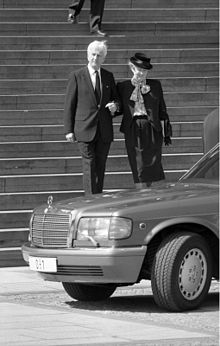
In the 1980s , the 126 series was considered a luxury sedan and a luxury symbol. Even if there were more expensive vehicles such as Rolls-Royce or Bentley , it was always present in the so-called “higher circles”.
In the 1980s, the 126 series became a vehicle icon in German politics and business. Members of the federal government were almost exclusively chauffeured in these vehicles, mostly with special protection . The then Federal Chancellor Helmut Kohl used a copy of type 126 and only had it decommissioned after it had reached a mileage of more than 500,000 km. In particular, the pictures of a completely destroyed car of this type became known, in which the then spokesman for the board of Deutsche Bank, Alfred Herrhausen , was killed in a bomb attack in 1989. It was astonishing that the 126 series was almost always ordered in blue or anthracite, but only rarely in black. The 126 was also used at the municipal level, for example as a vehicle for the mayor in Frankfurt am Main until at least the mid-1990s.
Numerous members of foreign governments also used the series if they gave preference to non-domestic manufacturers. Nelson Mandela , for example, used a Mercedes 500 SE. It was given to him in 1990 as President-elect of a modern South Africa by workers at the Mercedes-Benz of South Africa plant who had built it in free shifts.
The direct competitor model, the BMW E23 , did not pose any particular threat to sales of the W 126 and was almost exclusively driven by Bavarian government officials in government circles. Only its successor, the BMW E32 , was able to achieve a similarly important position in society and politics.

Numerous, mostly converted vehicles were delivered to the Arab region. The 126 series was popular in film productions when the owner's wealth was to be expressed. a. Beverly Hills Cop (500 SEL), My partner with the cold snout (560 SEL), Tomorrow never dies , Kamikaze 1989 with Rainer Werner Fassbinder , The big Bellheim with Mario Adorf (500 SEL), Peter Strohm with Klaus Löwitsch (560 SE and SEC) and The Prince from Zamunda (560 SEL and 500 SEL stretch limousine ), Die Hard: Now all the more with Bruce Willis (560 SEL).
The 126 series was also very popular as a private vehicle among Formula 1 racers. For example, in the 1983 Formula 1 season, 20 of 35 drivers privately drove a 126 series vehicle. a. Keke Rosberg , Niki Lauda and Nigel Mansell . Even Nelson Piquet , who as a driver from Brabham - BMW was given a BMW 745i as a company car, and his teammate Riccardo Patrese privately drove a Mercedes 500 SEL (Piquet) or 500 SE and 500 SEC (Patrese), although theirs was the engine supplier Teams were in direct competition with Mercedes.
Meaning after the end of production
Some new car buyers of the 126 series could not make friends with the successor model 140 series, which was often criticized because of its size ("Its appearance is too big, too disproportionate and not up-to-date", judged the trade press, the car train to Sylt was not passable due to the vehicle width) . Compared to the timelessly elegant-looking W126, the larger proportioned successor appeared to many potential buyers to be too ostentatious. These often switched to the competition or kept their vehicle until the appearance of the 220 series , which was also the reason for the larger range of first-hand used cars in the 126 series around 1998.
After the end of production, the 126 series was no longer interesting even for many used car buyers due to the unusually long construction time of twelve years, which was reflected in the price development. In particular, buyers who wanted to buy a used luxury vehicle just for reasons of prestige preferred the BMW 7-series E32 , which was much more modern at the time and only came onto the market in 1986. The used car prices of this direct and then current competing model were initially much higher, while W126 models from the first series in particular were offered at low prices on the used car market. The price ratio was later reversed. Most vehicles in the 126 series now fetch considerably higher prices than the same old and comparable 7-series BMW models in the E32 series.
The price level for the 126 series has already bottomed out, as the car is now increasingly being discovered as a timeless classic and demand is now picking up again. The manufacturer has recognized this with the Mercedes-Benz Young Classics and is now offering well-maintained or restored vehicles in the Mercedes-Benz world in Stuttgart or via the Internet.
The importance of the 126 series as a classic car
Due to the technical and optical innovations of the vehicle (plastic bumpers, recessed windshield wipers, etc.), the W126 was initially controversial in the classic car scene as a so-called classic car. The modern design was mainly responsible for this: in particular, the vehicles of the second series from 1985 with their smooth-surfaced paneling and flush light-alloy rims did not look like a vintage car to many viewers. The W126 is now also accepted as a classic car by the specialist press.
Motor variants and technical data
Sedan (1979–1985)
| Model (type) | engine | Displacement | power | |
|---|---|---|---|---|
|
280 S (126.021) |
Six-cylinder in- line engine M 110 |
2746 cc | 115 kW / 156 PS | not as a long version |
|
280 SE (126.022) / 280 SEL (126.023) |
136 kW / 185 PS | |||
|
380 SE (126.032) / 380 SEL (126.033) |
Eight-cylinder V-engine M 116 / M 117 |
3818 cc |
160 kW / 218 PS (until 10/1981) 150 kW / 204 PS (from 10/1981) |
|
|
500 SE (126.036) / 500 SEL (126.037) |
4973 cc |
177 kW / 240 PS (until 10/1981) 170 kW / 231 PS (from 10/1981) |
Saloon (1985–1991)
| Model (type) | engine | Displacement | Performance without cat |
Performance with cat |
|---|---|---|---|---|
|
260 SE * (126.020) |
Six-cylinder in- line engine M 103 |
2599 cc | not as a long version; 122 kW / 166 PS |
not as a long version; 118 kW / 160 PS¹ |
|
300 SE * (126.024) / 300 SEL * (126.025) |
2962 cc | 138 kW / 188 PS | 132 kW / 180 PS¹ | |
|
420 SE ** (126.034) / 420 SEL ** (126.035) |
Eight-cylinder V-engine M 116 / M 117 |
4196 cc |
160 kW / 218 PS (up to 9/1987) 170 kW / 231 PS (from 9/1987) |
150 kW / 204 PS¹ (until 9/1987) 165 kW / 224 PS¹ (from 9/1987) |
|
500 SE ** (126.036) / 500 SEL ** (126.037) |
4973 cc |
180 kW / 245 PS (until 9/1987) , 195 kW / 265 PS (from 9/1987) |
164 kW / 223 PS (up to 9/1987) 185 kW / 252 PS² (from 9/1987) |
|
|
560 SE ** (126.038) / 560 SEL ** (126.039) |
5547 cc |
220 kW / 300 PS ECE (up to 9/1986) 200 kW / 272 PS (until 9/1987) , 220 kW / 300 PS (from 9/1987) |
178 kW / 242 PS² (until 9/1987) 205 kW / 279 PS² (from 9/1987) |
* Manual gearbox, automatic gearbox optionally available
** only available with automatic gearbox
¹ can be retrofitted to Euro 2 standard using a cold run controller
² can be retrofitted to D3 standard using a cold run controller
C126 Coupé (1981–1985)
The coupé models have only been offered with eight-cylinder V engines since production began.
| Model (type) | engine | Displacement | power |
|---|---|---|---|
|
380 SEC (126,043) |
Eight cylinder V engine | 3818 cc | 150 kW / 204 PS |
|
500 SEC (126,044) |
4973 cc | 170 kW / 231 PS |
The Mercedes 380 SEC was already available with catalytic converter technology for a high surcharge.
C126 (1985-1991)
| Model (type) | engine | Displacement | Performance without cat |
Performance with cat |
|---|---|---|---|---|
|
420 SEC (126,046) |
Eight cylinder V engine | 4196 cc |
160 kW / 218 PS (up to 9/1987) 170 kW / 231 PS (from 9/1987) |
150 kW / 204 PS¹ (until 9/1987) 165 kW / 224 PS¹ (from 9/1987) |
|
500 SEC (126,044) |
4973 cc |
180 kW / 245 PS (until 9/1987) , 195 kW / 265 PS (from 9/1987) |
164 kW / 223 PS (up to 9/1987) 185 kW / 252 PS² (from 9/1987) |
|
|
560 SEC (126,045) |
5547 cc |
200 kW / 272 PS (until 9/1987) , 220 kW / 300 PS (from 9/1987) |
178 kW / 242 PS² (until 9/1987) 205 kW / 279 PS² (from 9/1987) |
¹ can be upgraded to Euro 2 standard using a cold run controller
² can be upgraded to D3 standard using a cold run controller
Diesel variants for the USA (1980–1991)
These models were exported to the United States and Canada . Mercedes already had experience with a diesel engine in its predecessor, the W 116. In Europe, S-Class diesels were still not offered: the diesel engines, which were still noisy and underperforming at the time, did not have the reputation of being built in luxury class in Europe and other markets - Suitable for cars. Another reason was the poor performance: with an acceleration time from 0 to 100 km / h in 13 to 16 seconds and a top speed of only 165 to 175 km / h, they did not meet the expectations of a luxury vehicle at the time among European customers. Diesel was mainly associated with fuel economy. Above all, diesel models complied with the fleet consumption requirements based on Californian legislation. Only with the successor model W140 did Daimler-Benz then also offer an S-Class turbo diesel in Europe.
| model | Model | engine | Displacement | power | receipt |
|---|---|---|---|---|---|
|
300 SD turbodiesel |
126,120 | Five-cylinder in- line engine OM 617 |
2998 cc |
89 kW / 121 PS (09.1979 to 10.1982) 92 kW / 125 PS (10.1982 to 08.1985) |
|
|
300 SDL turbo diesel |
126.125 | Six-cylinder in- line engine OM 603 |
2996 cc |
110 kW / 150 PS (02.1985 to 09.1987) |
|
|
350 SDL turbo diesel |
126,135 | 3449 cc |
100 kW / 136 PS (06.1990 to 08.1991) |
||
|
350 SD turbodiesel |
126.134 | 3449 cc |
100 kW / 136 PS (06.1990 to 08.1991) |
Driving performance and consumption
1979-1985
| model | power | Top speed |
0 - 100 km / h | Consumption* |
|---|---|---|---|---|
| 280 p | 115 kW (156 hp) | 200 km / h | 11.0 s | 15.1 l ** |
| 280 SE / SEL | 136 kW (185 hp) | 210 km / h | 10.0 s | 15.6 l ** |
| 380 SE / SEL | 150 kW (204 PS) 160 kW (218 PS) |
210 km / h 215 km / h |
9.8 s 9.6 s |
17.5 l ** |
| 500 SE / SEL | 170 kW (231 hp) 177 kW (241 hp) |
225 km / h 225 km / h |
8.1 s 8.0 s |
18.5 l ** |
* Average consumption ** before the engine revision as part of the "Mercedes-Benz energy concept"
1985-1991
The 560 SEL with 220 kW was the fastest mass-produced sedan in the world when it was launched, until BMW caught up with the 750 il in 1987 . Only the Alpina B7 Turbo based on the BMW E28 , produced in a small series of 278 pieces, achieved a top speed that was 10 km / h higher. The performance of the 560 SEL was comparable with that of the Porsche 911 Carrera 3.2 or the Ferrari Mondial . The consumption of the vehicles from 1985 onwards could be reduced considerably thanks to the improved engines.
| model | power | Top speed |
0 - 100 km / h | Consumption* | Empty weight |
|---|---|---|---|---|---|
| 260 SE | 118 kW (160 PS) 122 kW (166 PS) |
200 km / h 205 km / h |
11 s 10.5 s |
10.3 to 10.7 l | 1570 kg |
| 300 SE 300 SEL |
132 kW (180 PS) 138 kW (188 PS) |
205 km / h 210 km / h |
9.3 s 9.1 s |
10.5 to 10.9 l | SE 1570 kg SEL 1590 kg |
| 420 SE 420 SEL |
150 kW (204 PS) 160 kW (218 PS) 165 kW (224 PS) 170 kW (231 PS) |
210 km / h 218 km / h 220 km / h 222 km / h |
8.7 s 8.5 s 8.3 s 8.2 s |
11.5 to 11.9 l | SE 1640 kg SEL 1660 kg |
| 500 SE 500 SEL |
164 kW (223 PS) 180 kW (245 PS) 185 kW (252 PS) 195 kW (265 PS) |
220 km / h 230 km / h 230 km / h 235 km / h |
8.0 s 7.6 s 7.5 s 7.3 s |
12.0 to 12.5 l | SE 1670 kg SEL 1690 kg |
| 560 SE 560 SEL |
178 kW (242 PS) 200 kW (272 PS) 205 kW (279 PS) 220 kW (300 PS) |
228 km / h 238 km / h 242 km / h 250 km / h |
7.6 s 7.3 s 7.2 s 6.9 s |
13.6 l ** | SE 1800 kg SEL 1830 kg |
* Third mix ** Factory information
Equipment variants and characteristics
General
The vehicle equipment was quite limited when it was launched. Apart from power steering, there were no noteworthy features, but a long list of options for extras. Even things that are taken for granted today, such as a right outside mirror, electric window lifters or central locking, had to be paid for with a surcharge. Vehicles with little or no special equipment are referred to by enthusiasts as the "accountant version".
The entry-level model 280 S did not have a standard rev counter . Only the top model 500 SEL already had velor seats, four-way electric windows and central locking as standard.
However, the series has numerous well thought-out details that are often not recognizable at first glance. These include, among other things, the dirt-free entry area, completely recessed and parallel arranged windshield wipers, which are always parallel to the flow due to their design, thus preventing lifting at high speeds and cleaning 77% of the windscreen, a heat and sound-insulating assembly room between the engine and passenger compartment , a "Heizmatik" that keeps the selected interior temperature constant in all driving conditions without further intervention by the driver, also heats the front door panels and cools with optional air conditioning or a "workshop key" which, in contrast to the normal vehicle key, locks the trunk and the glove box cannot open. This can thus be given to the workshop or a parking service staff without the staff having access to the trunk or glove compartment.
Until the end of the construction period, the standard equipment was continuously upgraded, so that the vehicles from the last years of construction could be described as relatively well equipped. The 560 models had numerous equipment details as standard that were only available for the smaller models at an additional cost (e.g. air conditioning).
The coupé models were an exception. They had been much better equipped than the sedans since production began. Among other things, velor seats and electric windows were part of the basic equipment. However, coupés can still be upgraded with special equipment.
Even the subsequent retrofitting of special equipment was made a system for this series. The fans of these vehicles today often deny that there are any “fully equipped” vehicles because in individual cases one choice excludes another. Exact knowledge of the respective scope of series delivery at the time of production is also necessary in order to be able to talk about special equipment, as the scope of series delivery has been constantly expanded. Until 1988, however, were z. B. Eight-cylinder cars were delivered, which then had electric windows all round, but still no air conditioning. The subject of special equipment for this series becomes even more complex if one takes into account that extras were also installed at the customer's special request, which could not be found in any list of surcharges and which were calculated individually according to the effort. This point also makes it very difficult to assess the authenticity of class 126 cars. The data card and, in some cases, even the factory order are required for the assessment in order to distinguish retrofitted accessories from originally installed extras. In these cases, the specialist speaks of the “status according to the data card”, and wagons are sometimes also upgraded to this status. The delivery status of these cars can be determined with high accuracy from the manufacturer and also on the Internet in the forums for the W 126, even more than 30 years after production.
The equipment view of vehicles in the 126 series is divided into two parts: on the one hand, there are lovers of sporty converted cars who, with wider wheels, suspension kits for lowering, and sometimes with spoilers and side skirts, pay homage to an ideal that was often used as a used car in the 1990s Graced the red light districts of the big cities. On the other hand, there are fans of originality who prefer a car like the one that the Sindelfingen plant once delivered. In general, the latter vehicles are valued more highly today and sporty conversions are often seen as reducing their value.
In contrast to this, there are conversions by well-known tuners such as AMG , Brabus or SGS , which have a specific group of fans and are already achieving higher prices today if a car can be proven to have been made at that time and the scope of equipment from the tuning company is well documented - which is sufficiently early Year of construction, an H license plate for "contemporary converted" cars is also possible.
Interior
The interior was standard with Zebrano equipped -Holzblenden in the area of the dashboard, the center console and door panels. Surcharge, the "wood trim was Wurzelnuß " available (standard on coupes and 560ern). As is usual with Mercedes, the wooden panels on the center console were individually manufactured for each vehicle, depending on the optional equipment selected, since if the equipment features are missing, the openings for missing switches should not be covered with blind plugs, as is usual with the plastic panels of the smaller series.
Five different cover fabrics were officially available for seat covers and central parts of the door panels:
| material | standard |
| Velor | Standard for 500 SEL, 560 SE / SEL and Coupés for an extra charge |
| MB-Tex ( synthetic leather ) |
for a surcharge, not for 500 SEL, 560 SE / SEL and Coupés |
| Leather * | for a surcharge for all 560s optionally without a surcharge |
|
Amaretta (synthetic fiber, similar to Alcantara ) |
for a surcharge for all 560s optionally without a surcharge |
(*) Until the introduction of the soft leather interior from model year 89 on, the middle parts of the door panels were covered with the synthetic leather "MB-Tex" on vehicles with leather interior.
For the SEL models, a four-seat variant with two individual seats in the rear - similar to those of the coupé models - was available as a coupé seat system (option 224) for a high surcharge . This could not be combined with fabric and MB-Tex and has an electric seat adjustment for each individual seat. The rear seats were electrically adjustable lengthways and, if desired, also height.
This seating system also had the sports seats of the Coupé models at the front and, if the velor cover material was chosen, the same striated covers.
Exterior fittings
Externally, there are no features that distinguish the individual models from one another. The only equipment, headlamp wipers and alloy wheels , were available as options for all models. If the SA code 260 is selected, the type designation on the trunk lid is omitted for an outsider to identify a model.
First series vehicles, including the coupés, generally have steel rims with hubcaps. The latter were made of plastic - for the first time in a Mercedes series vehicle - to save weight. Alloy rims were available at an additional cost. On vehicles of the second series, light alloy rims were standard on the coupes and sedans with 5.6 liter engines. A headlight wiper system was available at an additional cost and was also standard on the 560 models.
Functional equipment
The W126 is the first vehicle from Mercedes-Benz for which electric seat adjustment was available. In the long versions, an electrically adjustable rear seat bench was also available, which can be adjusted lengthways by 100 mm. Adjusting the seat changes the incline of the backrest. The entire rear seat can be adjusted. With the optional coupé seating, the two individual seats in the rear can be adjusted separately.
There were a large number of optional extras. They ranged from car telephones ( B-Netz , later C-Netz ) to heated seats for all four seats and a cool box in the trunk. Extras such as door exit lights, illuminated make-up mirrors in the sun visors or an electrically operated sun protection blind for the rear window were also available - a matter of course today, a special feature at the time.
The on - board computer called the “travel calculator” at Mercedes-Benz is a very seldom-sold option . If this option was selected, the consumption display was omitted, instead the rev counter was integrated into the left round instrument together with the oil pressure, tank and water temperature display. The display unit for the trip computer is located in the right round instrument, where the tachometer and clock were normally installed. The control panel of the on-board computer is located in the center console between the seats.
In addition to the official price list, there was also the so-called “customer request special price list ” . This contained numerous special options such as standard holders in the front fenders for government vehicles, curtains for the rear and rear side windows or cardanic reading lights in the rear. The surcharge for options from this list was very high, the latter lights alone costing several thousand D-Marks.
In this price list there were also special equipment packages such as B. an office equipment with a fax machine integrated into the rear center armrest and a personal computer with flat screen built into the passenger seat back, which could be operated from the right rear seat. For the comfort of the rear passengers, the sliding roof and the longitudinal adjustment of the front passenger seat could also be operated using switches in the rear door.
The coupé models are equipped with so-called belt pullers, which bring the seat belts within the reach of the driver and front passenger after they have entered. This equipment makes sense because the belts are relatively far back due to the longer doors.
Purchase price development
The cheapest vehicle in the W 126 series, the 280 S, cost around DM 35,900 when it was launched in September 1979, while the top model at the time, the 500 SEL, was available for around DM 56,200. The coupé models presented in October 1981 initially cost around DM 69,500 (380 SEC) and around DM 73,900 (500 SEC).
At the end of production in October 1991, the starting price for the W 126 series was now DM 66,200 for a 260 SE. The original top model, the 500 SEL, cost around DM 101,100. The 560 SEL, the later top model, which was only offered from September 1985, cost around DM 141,500 at the end, the coupé variant 560 SEC DM 155,700.
Price development based on some model examples
280 SE and successor models 260 SE / 300 SE:
| Type | Price DM 1980 | Price DM 1985 | Price DM 1991 |
|---|---|---|---|
| 260 SE | - | 50 637.00 | 66 177, - |
| 280 SE | 40 341.00 | - | - |
| 300 SE | - | 54 891.00 | 71 136.00 |
380 SE and successor model 420 SE:
| Type | Price DM 1980 | Price DM 1985 | Price DM 1991 |
|---|---|---|---|
| 380 SE | 48 511.00 | - | - |
| 420 SE | - | 70 623, - | 86 868.00 |
500 SE:
| Type | Price DM 1980 | Price DM 1985 | Price DM 1991 |
|---|---|---|---|
| 500 SE | 52 681.00 | 76 437.00 | 93 708, - |
560 SEL:
| Type | Price DM 1980 | Price DM 1985 | Price DM 1991 |
|---|---|---|---|
| 560 SEL | - | 121 410, - | 141 531.00 |
380 SEC and successor model 420 SEC:
| Type | Price DM 1981 | Price DM 1985 | Price DM 1991 |
|---|---|---|---|
| 380 SEC (from 1981) |
69 495.00 | - | - |
| 420 SEC | - | 94 563, - | 113 544.00 |
500 SEC:
| Type | Price DM 1981 | Price DM 1985 | Price DM 1991 |
|---|---|---|---|
| 500 SEC (from 1981) |
73 902, - | 100 377.00 | 120 384.00 |
560 SEC:
| Type | Price DM 1980 | Price DM 1985 | Price DM 1991 |
|---|---|---|---|
| 560 SEC | - | 133 608.00 | 155 724.00 |
Production numbers
The total production figure is 892,123, of which 818,063 sedans and 74,060 coupes. 473,209 vehicles of the total production were made up of vehicles of the first series, which were built up to September 1985.
About a third of the total production (approx. 300,000 vehicles) was exported to the USA. Another third was sold in Germany. Most of the rest was exported to Western Europe, Japan and the Middle East. 1465 sedans were produced as special protection vehicles.
Limousines
| Type | number of pieces | including vehicles with special protection ex works |
|---|---|---|
| 260 SE | 20,836 | - |
| 280 p | 42,996 | - |
| 280 SE | 133.955 | - |
| 280 SEL | 20,655 | - |
| 300 SE | 105,422 | - |
| 300 SEL | 40,956 | - |
| 380 SE | 58,236 | 86 |
| 380 SEL | 27,014 | 88 |
| 420 SE | 13,996 | 229 |
| 420 SEL | 74,017 | 63 |
| 500 SE | 33,418 | 3 (1st series) 7 (2nd series) |
| 500 SEL | 72,693 | 376 (1st series) 2 (1st series, special conversions Vatican ) 262 (2nd series) |
| 560 SE | 1252 | - |
| 560 SEL | 75,071 | 349 |
Total production of sedans with petrol engines: 720,517
Coupes
| Type | number of pieces |
|---|---|
| 380 SEC | 11,267 |
| 420 SEC | 3680 |
| 500 SEC | 30.184 |
| 560 SEC | 28,929 |
Total production of coupés: 74,060
Export models Canada / USA
| Type | number of pieces |
|---|---|
| 300 SD turbodiesel |
78,725 |
| 300 SDL Turbo |
13,830 |
| 350 SD Turbo |
2066 |
| 350 SDL Turbo |
2925 |
Total production of sedans with diesel engines: 97,546
Long-term quality
General
A 126 series car is considered a robustly built vehicle. Mileage of 500,000 km and more with the first engine and the first gearbox is not uncommon, especially with eight-cylinder engines, with good maintenance and care. As a rule, the then exotic special equipment such as electric seat adjusters still work without any problems today.
This was already confidently stated in a Mercedes advertisement for the 126 series from 1986: "After 266,623 km, something bigger was exchanged for the first time: the owner."
Today, the Mercedes-Benz-specific variant of the hydropneumatic suspension, which was only available as an option for the SEL models with eight-cylinder engine, is particularly susceptible to defects : This contains seat valves to control and regulate the suspension system, and not the slide valves introduced by competitors. Seat valves tend to stick and form deposits on the seat surfaces after a long period of inactivity. In contrast to slide valves, their self-cleaning capacity is limited, which - in addition to normal maintenance and the scheduled replacement of wear parts - makes complex and therefore expensive repairs necessary. The optionally available automatic climate control for failures is also known. The normal air conditioning system is therefore considered to be a better choice because the temperature is also electronically controlled with this. The air conditioning system also has the advantage that the temperature can be set separately for each side of the interior, a function that the automatic air conditioning system lacks. The latter only regulates the intensity of the air flow from the fan.
Rust damage in the lower area of the rear window frame is not uncommon and occurs more and more in coupé models, as their rear windows are larger and therefore heavier. In addition, these vehicles are less torsion-resistant due to the lack of a B-pillar . This damage can also occur with the limousines. Repairs can be very expensive here - depending on the progress of the rust attack.
As with almost all self-supporting bodies, the rocker panels and jack supports are critical. There is also a general weak point in the 126 series cars that almost all Mercedes series have: the battery box and the water drains, which are often clogged by leaf particles. The protective caps of the sill ends in the rear wheel arches (the so-called “bananas”) must also be present. Overall, however, the W126 series - similar to the “Babybenz” W 201 series - is one of the most solid, best-built vehicles with a self-supporting body: these vehicles had received the phosphating immersion bath after the body shell, which was later replaced by the much less effective galvanizing of the coil sheets. The bodies were still painted with two-component paints - the two-component paintwork was not replaced by water-based paints in the Sindelfingen and Bremen plants until after the end of the 126 series in August 1993. Further corrosion protection with the yellow plastic spray paint that is typical of Daimler-Benz Underbody protection is considered to be very good and durable. Vehicles that have always been parked in a ventilated garage can still be rust-free after about 30 years. Objectively better than the Mercedes cars of the late 1980s in terms of corrosion protection were only Audi cars that were fully galvanized up to 2005.
spare Parts
In addition, the availability of spare parts for these cars is still very good today: practically all technical components susceptible to wear and tear that may be required to keep the train running can be delivered at short notice. The 126 series has solid electrical equipment. Although these cars usually contain a lot of electrics due to the extensive equipment, the functioning of the electrics is still somewhat understandable to the layman, because electronics are only found in the form of a few control devices that can be checked in the exchange and exclusion process. The 126 series was the last S-Class without the CAN bus , the functioning of which can no longer be secured without complex test equipment, software and training knowledge. The 126 series is therefore well suited for people who can largely maintain and repair their vehicles themselves.
Conversions and armored vehicles
In-house
Special protection vehicles
In addition to the normal series vehicles, the 126 series was also offered ex works as a special protection vehicle of resistance class B6 / B7. On the outside, these vehicles also differ from the standard models in terms of modified, massive window frames and different wheel / tire combinations. A total of 1465 vehicles were produced in a separate production area with a capacity of 150 vehicles per year in special protection design.
In order not to endanger the safety of the owners, no information is officially disclosed about these vehicles, some of which are still in use today.
Vehicles for the Vatican
In 1983 and 1985, a converted vehicle based on the 500 SEL was produced as a so-called Papamobile for the Pope . The wheelbase of both vehicles with special protection was extended by 200 mm and the roof increased by 30 mm. The vehicle produced in 1983 complements the Daimler AG vehicle fleet for representative vehicles; the vehicle produced in 1985 was manufactured according to the Vatican's specifications and handed over to Pope John Paul II . It replaced the previously used W 100 as the official papal vehicle and, along with other vehicles, was also used by Benedict XVI. utilized.
The Pope was able to show himself to the public through a sliding roof in the rear that was extended by 100 mm. It was protected from the wind by a 6 mm thick polycarbonate shield, which could be extended up to a speed of 30 km / h. The top speed of this sedan with an unladen weight of 2673 kilograms was 160 km / h.
Outside the factory
In the 1980s, numerous vehicle tuners tried to make a name for themselves, especially with the 126 series. Some succeeded ( AMG , Brabus ), others disappeared from the market after a few years. Many conversions were limited to the body and interior areas, and very few companies offered engine tuning.
As far as we know today, the boom in 126 tuning began in 1982, when the Styling Garage (SGS) based in the Hamburg area presented two converted W126s as well as an extremely converted VW Golf I at the IAA in Frankfurt . This aroused great interest among well-to-do visitors from the Arab region, so that the “Styling Garage” from then on also offered extreme conversions of the 126 series. The most expensive conversion variants cost up to ten times that of a factory model - prices that were actually paid. The renovation program included u. a. Convertibles , double door coupes and stretch limousines . With such high profit expectations, other bodywork companies jumped on the bandwagon and brought their own creations onto the market.
Subsequent conversion of a 500 SEL to a shooting break from Japan
Convertible conversion of a 500 SEC from Styling Garage
Koenig Specials from Munich produced some heavily widened vehicles and also offered engine tuning using a compressor . Despite the demand that is no longer there today, Koenig is one of the few companies that still offers parts from the tuning program of that time.
Other well-known remodeling companies were ABC-Exclusiv, Duchatelet, Gemballa, Lorinser and Trasco.
Many of these companies also manufactured stretch limousines based on the W126, some of them also based on the coupé. These vehicles usually had four doors, rarely six. Often completely rebuilt interior fittings or gold-plated chrome strips were used, and TV sets and stereo systems consisting of several components were often used. However, some companies only made subtle changes to the vehicle. In addition to modified bumpers and rocker panels, the US headlights of the first series were often used here. Lowering the chassis and using wide tires on light alloy rims was the rule for all conversion variants. Chrome wheel arch strips were also popular, but their attachment often caused rust damage to the body.
The company "Custom City" from South Africa built a spectacular hearse based on the W126, which is often mistaken for a show vehicle. In principle, it is a stretch limousine with a combi-like rear structure and three rear axles.
The Binz company built a station wagon version of the 126 series.
Well-known vehicles for celebrities
The numerous vehicles made for Hamad bin Hamdan al Nahyan , also known as the "Rainbow Sheikh", became well known in the specialist press . His family crest shows a rainbow. He always ordered vehicles painted white with gold-plated chrome parts and a decorative strip in rainbow colors. Today, vehicles from his stock occasionally appear on the German used car market.
The best known, however, were his six W-126 models, each of which was completely painted in one color of the rainbow (red, orange, yellow, green, blue, purple). The special thing about these vehicles was that all the details of the vehicle were kept in the same color as the car, from the wooden panels in the interior to the dials of the instruments and the chrome parts on the outside. Even the raised parts of the front turn signal lights and the rear lights were in the body color. Curious: the vehicles came with two AK-74s , which were also kept in the same color as the car.
For Juliana von Oranien-Nassau , former Queen of the Netherlands , a W-126 sedan was converted into a four-door convertible by the Swiss company Caruna. The vehicle was used in Porto Ercole , the summer residence of the royal family.
Nelson Mandela received a red Mercedes 500 SE as a present from the workers of Mercedes-Benz South Africa in 1990 , which they completed in their free shifts.
Monteverdi tiara
In 1982, the Swiss automobile manufacturer Monteverdi presented the Monteverdi Tiara , a four-door sedan based on the 126 series. The Tiara has the body and drive technology with the 3.8-l and 5.0-l V8 engines of the V126- Models with a long wheelbase, but the front and rear have been completely redesigned. The front of the car was angular; it received four round headlights framed in chrome. Monteverdi installed the tail lights of the Peugeot 505 at the rear . The voluminous bumpers of the production models have been replaced by narrow units framed in chrome; the so-called Sacco boards were omitted. In the interior, wider but flatter headrests and a different steering wheel were installed. Monteverdi planned to sell the Tiara sedan through the Mercedes dealer network from 1982 onwards. Series production, however, did not materialize. At least three copies were made. Monteverdi offered them at a retail price of 183,000 Swiss francs.
literature
- Heribert Hofner: The S-Class from Mercedes-Benz: From the culture of driving. Bechtermünz, Augsburg 1997, ISBN 3-86047-589-4 .
- Christof Vieweg among others: Everything about the Mercedes-Benz-S-Class: a publication of the Daimler-Benz-Service. Ed .: Daimler-Benz AG, Department VSE / I, Stuttgart 1998, ISBN 3-932786-04-1 .
- Matthias Röcke: The big Mercedes S-Class book: all model series from W 108 to W 140 (1965 to today). Heel, Königswinter 1991, ISBN 3-89365-234-5 .
- Matthias Röcke, Helmut Baaden (Red.): The new big Mercedes S-Class book. Heel, Königswinter 2003, ISBN 3-89880-158-6 .
- RM Clarke: Mercedes S-Class - 1980–1991. Brooklands Books, 2001, ISBN 1-85520-581-5 .
- Mercedes S-Class 280 S / 280 SE / 380 SE / 500 SE from September 1979 to 1984. Volume 662. Repair instructions. Bucheli Verlag, ISBN 3-7168-1585-3 .
- New sidereal time: The Mercedes W126 is 30 years old. In: Oldtimer Market . 10/2009, p. 14ff.
- Hans-Peter Lange: The 126 codes - now decrypted. Ed .: Mercedes-Benz Interest Community eV, Bonn 2012, ISBN 978-3-9815090-0-7 .
Individual evidence
- ↑ AutoBild: 30 years of the Mercedes W 126
- ↑ a b c d AutoBild.de: Sacco's masterpiece
- ↑ Zero scrub radius
- ↑ http://www.rp-online.de/auto/news/promis-haben-ihre-schoensten-autos-1.1525750
- ^ The W 126 in films
- ↑ The C126 in movies
- ↑ The V126 in movies
- ↑ Auto, motor und sport , edition 7/1983, p. 170 f. "Stars and stars - Most Formula 1 drivers drive Mercedes privately.
- ↑ a b Classic Driver: "Mercedes-Benz S-Class W140"
- ↑ AutoBild: "The Duel"
- ↑ Daimler AG: 300 SD Turbodiesel in: Mercedes-Benz Public Archive . Retrieved October 17, 2018
- ↑ Daimler AG: 300 SDL Turbodiesel in: Mercedes-Benz Public Archive . Retrieved October 17, 2018
- ↑ Daimler AG: 350 SDL Turbodiesel in: Mercedes-Benz Public Archive . Retrieved October 17, 2018
- ↑ Daimler AG: 350 SD Turbodiesel in: Mercedes-Benz Public Archive . Retrieved October 17, 2018
- ↑ [1]
- ↑ Windshield wipers arranged in parallel
- ↑ engine room
- ↑ Heizmatik
- ↑ Workshop key
- ↑ Special equipment ( Memento from December 29, 2009 in the Internet Archive ) Scan of an advertising brochure at http://www.s-klasse-club.de/
- ↑ http://www.s-klasse-club.de/bilder/galerie/werbung126/1986_angebote_014.pdf (link not available)
- ^ Press release from Daimler AG ( Memento from April 27, 2014 in the Internet Archive )
- ↑ [2] illustrated article about 126 conversions at http://einestages.spiegel.de/
- ↑ Official website of SGS Styling Garage (accessed June 12, 2010)
- ↑ [3] today's product range
- ↑ Hearse ( Memento from September 18, 2008 in the Internet Archive ) Fig. Of the hearse, 39th vehicle from above
- ↑ [4] Report with photo
- ↑ Illustration of the vehicles, magazine scan below center
- ↑ Tom Grünweg: Open Mercedes 380 SEL: A convertible for the queen - mobility. In: Spiegel Online . June 26, 2009. Retrieved June 9, 2018 .
- ↑ http://jalopnik.com/5292814/dutch-royal-family-restores-1985-mercedes-380-sel-caruna
- ↑ http://www.7-forum.com/news/2005/technoclassica/mercedes.php
- ↑ Monteverdi Tiara ( Memento from September 15, 2012 in the web archive archive.today )
- ^ Sales brochure for the Monteverdi Tiara from 1982
Web links
- AutoBild: Sacco's masterpiece
- Spiegel Online: For the 25th anniversary of the W126
- AutoBild: Cars without age ( Memento from June 20, 2007 in the Internet Archive )
- Mercedes-Benz S-Class Club eV In: s-klasse-club.de. September 23, 1927, accessed November 16, 2018 .
| Vehicle class | 1920s | 1930s | 1940s | ||||||||||||||||
| 6th | 7th | 8th | 9 | 0 | 1 | 2 | 3 | 4th | 5 | 6th | 7th | 8th | 9 | 0 | 1 | 2 | 3 | 4th | |
| Compact class | W 15 (type 170) | ||||||||||||||||||
| W 23 (type 130) | |||||||||||||||||||
| W 30 (type 150) | |||||||||||||||||||
| W 28 (type 170 H) | |||||||||||||||||||
| Middle class | W 02 (type Stuttgart 200) | W 136 / W 149 (types 170 V / 200 V) | |||||||||||||||||
| W 11 (type Stuttgart 260) | W 143 (type 230 n) | ||||||||||||||||||
| W 21 (type 200/230) | W 153 (type 230) | ||||||||||||||||||
| W 138 (type 260 D) | |||||||||||||||||||
| upper middle class | W 03 / W 04 / W 05 (types 300/320/350) | W 18 (type 290) | |||||||||||||||||
| W 10 / W 19 (types 350/370/380) | W 142 (type 320) | ||||||||||||||||||
| W 22 | |||||||||||||||||||
| Upper class | Type 400 & Type 630 | W 24 / W 29 / W 129 (types 500 K / 540 K / 580 K) | |||||||||||||||||
| W 08 (type Nürburg 460/460 K / 500 / type 500 N) | |||||||||||||||||||
| W 07 / W 150 (types 770/770 K) | |||||||||||||||||||
| Sports car | Model K | ||||||||||||||||||
| W 06 (type S / SS / SSK / SSKL) | W 24 / W 29 / W 129 | ||||||||||||||||||
| Off-road vehicle | W 103 (type G1) | W 31 (type G4) | |||||||||||||||||
| W 133 III (type 170 VG) / W 139 (type 170 VL) / W 152 (type G5) | |||||||||||||||||||
| Vans | L 3/4 | L 1000 Express | L 301 | ||||||||||||||||
| L 300 | |||||||||||||||||||
